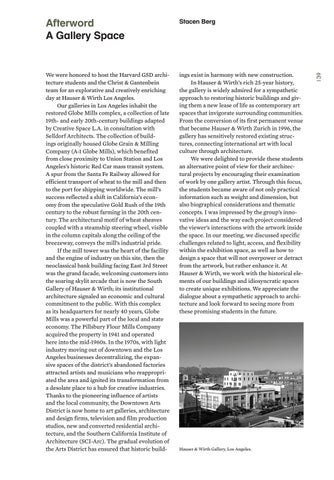Stacen Berg
We were honored to host the Harvard GSD architecture students and the Christ & Gantenbein team for an explorative and creatively enriching day at Hauser & Wirth Los Angeles. Our galleries in Los Angeles inhabit the restored Globe Mills complex, a collection of late 19th- and early 20th-century buildings adapted by Creative Space L.A. in consultation with Selldorf Architects. The collection of buildings originally housed Globe Grain & Milling Company (A-1 Globe Mills), which benefited from close proximity to Union Station and Los Angeles’s historic Red Car mass transit system. A spur from the Santa Fe Railway allowed for efficient transport of wheat to the mill and then to the port for shipping worldwide. The mill’s success reflected a shift in California’s economy from the speculative Gold Rush of the 19th century to the robust farming in the 20th century. The architectural motif of wheat sheaves coupled with a steamship steering wheel, visible in the column capitals along the ceiling of the breezeway, conveys the mill’s industrial pride. If the mill tower was the heart of the facility and the engine of industry on this site, then the neoclassical bank building facing East 3rd Street was the grand facade, welcoming customers into the soaring skylit arcade that is now the South Gallery of Hauser & Wirth; its institutional architecture signaled an economic and cultural commitment to the public. With this complex as its headquarters for nearly 40 years, Globe Mills was a powerful part of the local and state economy. The Pillsbury Flour Mills Company acquired the property in 1941 and operated here into the mid-1960s. In the 1970s, with light industry moving out of downtown and the Los Angeles businesses decentralizing, the expansive spaces of the district’s abandoned factories attracted artists and musicians who reappropriated the area and ignited its transformation from a desolate place to a hub for creative industries. Thanks to the pioneering influence of artists and the local community, the Downtown Arts District is now home to art galleries, architecture and design firms, television and film production studios, new and converted residential architecture, and the Southern California Institute of Architecture (SCI-Arc). The gradual evolution of the Arts District has ensured that historic build-
ings exist in harmony with new construction. In Hauser & Wirth’s rich 25-year history, the gallery is widely admired for a sympathetic approach to restoring historic buildings and giving them a new lease of life as contemporary art spaces that invigorate surrounding communities. From the conversion of its first permanent venue that became Hauser & Wirth Zurich in 1996, the gallery has sensitively restored existing structures, connecting international art with local culture through architecture. We were delighted to provide these students an alternative point of view for their architectural projects by encouraging their examination of work by one gallery artist. Through this focus, the students became aware of not only practical information such as weight and dimension, but also biographical considerations and thematic concepts. I was impressed by the group’s innovative ideas and the way each project considered the viewer’s interactions with the artwork inside the space. In our meeting, we discussed specific challenges related to light, access, and flexibility within the exhibition space, as well as how to design a space that will not overpower or detract from the artwork, but rather enhance it. At Hauser & Wirth, we work with the historical elements of our buildings and idiosyncratic spaces to create unique exhibitions. We appreciate the dialogue about a sympathetic approach to architecture and look forward to seeing more from these promising students in the future.
Hauser & Wirth Gallery, Los Angeles.
139
Afterword A Gallery Space
